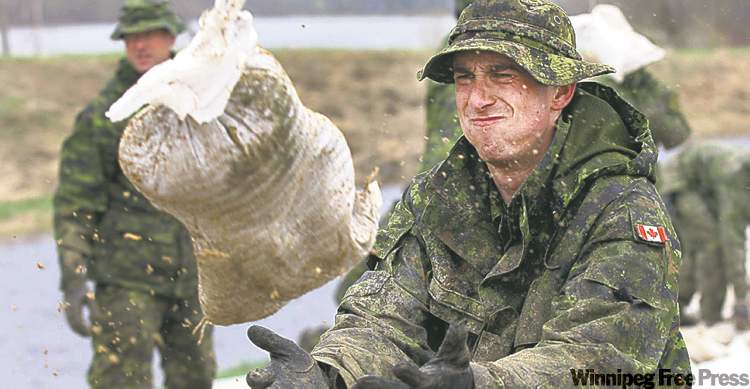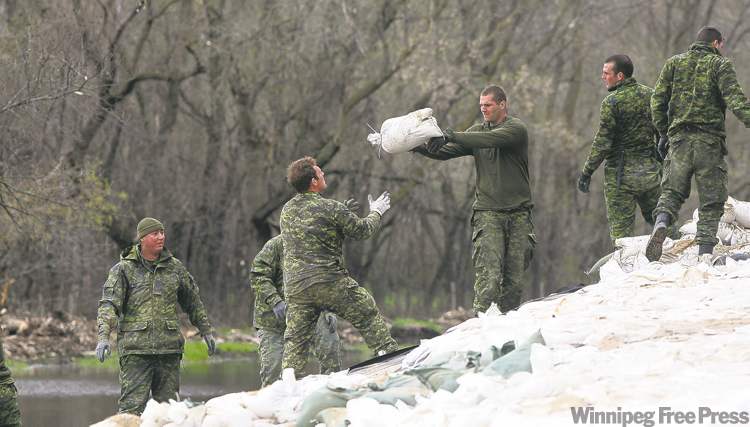Flood mission accomplished
Canadian Forces personnel wrap up Manitoba sandbagging campaign
Advertisement
Read this article for free:
or
Already have an account? Log in here »
To continue reading, please subscribe:
Monthly Digital Subscription
$0 for the first 4 weeks*
- Enjoy unlimited reading on winnipegfreepress.com
- Read the E-Edition, our digital replica newspaper
- Access News Break, our award-winning app
- Play interactive puzzles
*No charge for 4 weeks then price increases to the regular rate of $19.00 plus GST every four weeks. Offer available to new and qualified returning subscribers only. Cancel any time.
Monthly Digital Subscription
$4.75/week*
- Enjoy unlimited reading on winnipegfreepress.com
- Read the E-Edition, our digital replica newspaper
- Access News Break, our award-winning app
- Play interactive puzzles
*Billed as $19 plus GST every four weeks. Cancel any time.
To continue reading, please subscribe:
Add Free Press access to your Brandon Sun subscription for only an additional
$1 for the first 4 weeks*
*Your next subscription payment will increase by $1.00 and you will be charged $16.99 plus GST for four weeks. After four weeks, your payment will increase to $23.99 plus GST every four weeks.
Read unlimited articles for free today:
or
Already have an account? Log in here »
Hey there, time traveller!
This article was published 28/05/2011 (5302 days ago), so information in it may no longer be current.
The Canadian Forces have ended Operation Lustre, an 18-day mission that saw 1,800 military personnel reinforce Manitoba’s flood fight.
Receding flows on the Assiniboine River allowed the Manitoba government to let the Canadian military know the province will handle what’s left of the spring flood fight on its own.
Between May 9 and 26, Canadian Forces helped repair dikes along the Assiniboine east of Portage la Prairie and dikes along the Portage Diversion, which sent more water toward Lake Manitoba than the artificial channel was designed to carry. The military also monitored dikes on the ground and from the air.

Regular Forces personnel and reservists assisted with evacuations from the flood zone and protected 160 private homes, mostly in the RM of Portage la Prairie, with sandbags and water dikes. The military also worked in Brandon and along Lake Manitoba.
In total, military personnel filled 167,000 sandbags and placed another 440,000, according to Department of National Defence tallies.
“I’m really proud of how the men and women responded out there,” Defence Minister Peter MacKay said Friday in a telephone interview from Ottawa. “A staggering number of sandbags were moved.”
MacKay said he is satisfied with the speed and scale of the military’s response to flooding along the Assiniboine in Manitoba and in southern Quebec, where the Richelieu River spilled its banks.
“As we got into it, we saw the enormity of the task and brought in more equipment and more personnel,” MacKay said of the Manitoba fight. “At no time did we scrimp in doing so.”
Some of the personnel on the ground in Manitoba were bound for Afghanistan. MacKay said the flood fight did not compromise the Afghan mission, as the military plans to have the capacity to handle domestic emergencies at the same time as operations on foreign soil.
“We’ve proven our ability to do so,” he said, noting the Manitoba, Quebec, Afghan and Libyan missions coincided. “We’ve always struck a very deliberate balance between what you can call the home and away game.”
The province has already thanked the military in a public ceremony at the Manitoba legislature. On Friday, Premier Greg Selinger issued another statement of gratitude.
The end of the military mission here does not mean Manitobans can relax, said Manitoba Emergency Measures Minister Steve Ashton.
Work is ongoing to protect homes, cottages and farms along Lake Manitoba, which is expected to reach post-regulation record highs in June. First Nations at Lake St. Martin and elsewhere will be flooded for months.
“The departure of the military is by no means a signal the flood is over,” Ashton said by phone from Thompson. “We still need volunteers.”
Some lakefront communities remain desperate, but provincial officials were careful to stress the military was called in to execute a specific role along the Assiniboine and Portage Diversion, where dike failures appeared probable.
“They come to perform specific tasks when there are no other resources available,” Ashton said. “We could not, given the emergency situation, mobilize resources quickly enough to do what we needed to accomplish.”
Military members should not be called on to simply serve as a workforce, MacKay agreed. “That certainly isn’t the intent, and it’s not the mandate. We are there to respond in times of emergency.”
This mandate has been abused, MacKay added. “The most blatant request was the request (to) respond to a snowstorm in Toronto,” the defence minister said, referring to the infamous move by former Toronto mayor Mel Lastman in 1999. “That clearly is not the accurate depiction of what Canadian Forces are tasked to do.”

bartley.kives@freepress.mb.ca
Operation Lustre
Military resources deployed to fight spring flooding in Manitoba this spring:
Regular army: 1,400 personnel from 1 Canadian Mechanized Brigade Group and 1 Area Support Group, based at CFB Shilo, Man. and CFB Edmonton.
Army reservists: 200 personnel from 38 Canadian Brigade Group, based in Manitoba, Saskatchewan and northwestern Ontario.
Navy: 130 navy personnel, primarily reservists from across Canada. Also, a dozen small boats and a port-inspection dive team.
Air force: 70 personnel.
Helicopters: Six CH-146 Griffon helicopters from 408 “Goose” tactical squadron in Edmonton and 400 “City of Toronto” tactical squadron in Borden, Ont.
Also, one CH-146 search-and-rescue Griffon helicopter from 424 “Tiger” Transport and Rescue Squadron, 8 Wing, in Trenton, Ont.
Patrol aircraft: One CP-140 Aurora maritime patrol aircraft from 407 “Demon” Maritime Patrol Squadron, 19 Wing, in Comox, BC.
Source: Canadian Forces


